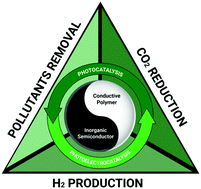Hybrid materials based on conjugated polymers and inorganic semiconductors as photocatalysts: from environmental to energy applications
Abstract
Photocatalysts provide a sustainable way to remove pollutants or store energy in the form of solar fuels by processes such as water splitting and CO2 photoreduction (artificial photosynthesis). Research in this topic is an expansive field evidenced by the large number of contributions published in the past few years. Hybrid photocatalysts based on inorganic semiconductors (ISs) and conjugated polymers (CPs) have emerged as novel promising photoactive materials. In addition to the well-known behaviour of ISs in photocatalytic processes, CPs have emerged as an interesting alternative to improve the photocatalytic efficiency due to the possibility of controlling their optoelectronic, textural and morphological properties at the molecular level. Thus, the synergy between ISs and CPs leads to more efficient photocatalysts with enhanced light absorption in the overall solar spectrum, improved photocharge generation and transport, higher stability to photo-corrosion and higher surface areas. Here, we present an overview of the advances in the development of hybrid IS–CP photocatalysts for pollutant degradation and energy conversion through water splitting, CO2 reduction and/or N2 fixation using photo- and photo(electro)catalytic processes.



 Please wait while we load your content...
Please wait while we load your content...